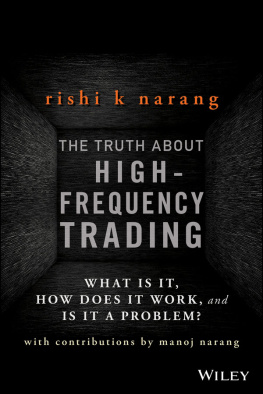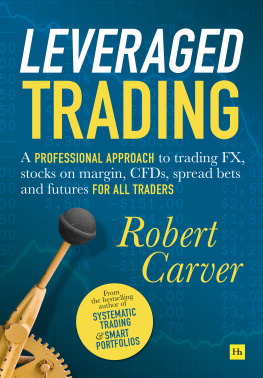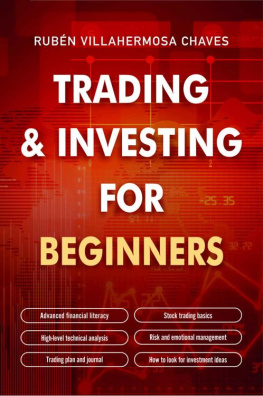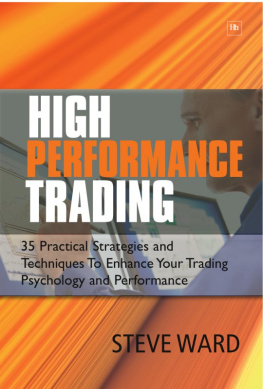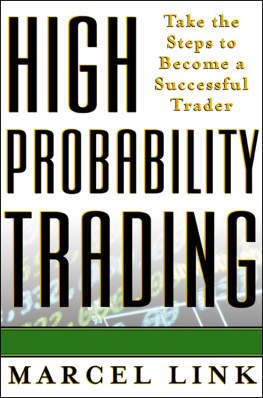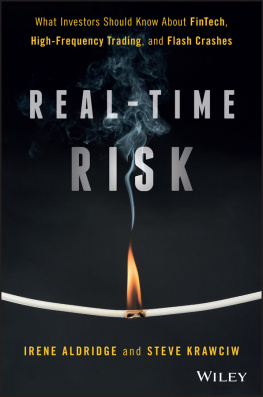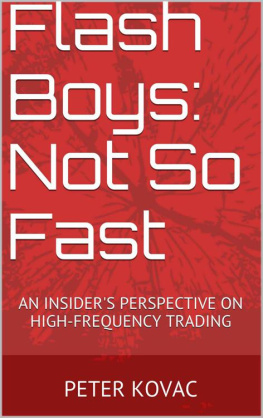Gewei Ye - High Frequency Trading Models
Here you can read online Gewei Ye - High Frequency Trading Models full text of the book (entire story) in english for free. Download pdf and epub, get meaning, cover and reviews about this ebook. year: 2010, genre: Business. Description of the work, (preface) as well as reviews are available. Best literature library LitArk.com created for fans of good reading and offers a wide selection of genres:
Romance novel
Science fiction
Adventure
Detective
Science
History
Home and family
Prose
Art
Politics
Computer
Non-fiction
Religion
Business
Children
Humor
Choose a favorite category and find really read worthwhile books. Enjoy immersion in the world of imagination, feel the emotions of the characters or learn something new for yourself, make an fascinating discovery.

High Frequency Trading Models: summary, description and annotation
We offer to read an annotation, description, summary or preface (depends on what the author of the book "High Frequency Trading Models" wrote himself). If you haven't found the necessary information about the book — write in the comments, we will try to find it.
High Frequency Trading Models — read online for free the complete book (whole text) full work
Below is the text of the book, divided by pages. System saving the place of the last page read, allows you to conveniently read the book "High Frequency Trading Models" online for free, without having to search again every time where you left off. Put a bookmark, and you can go to the page where you finished reading at any time.
Font size:
Interval:
Bookmark:
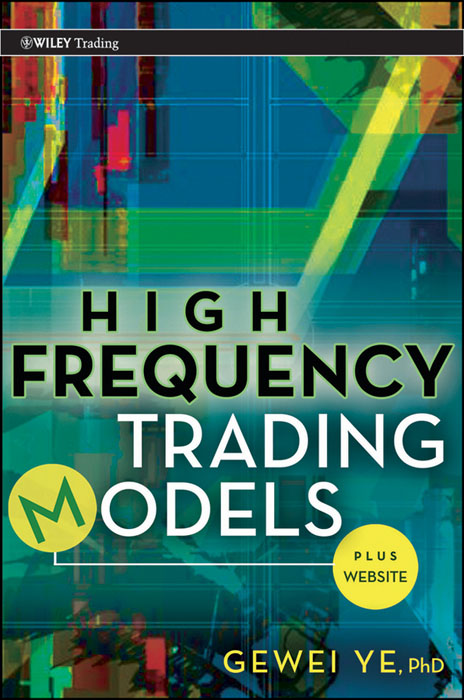
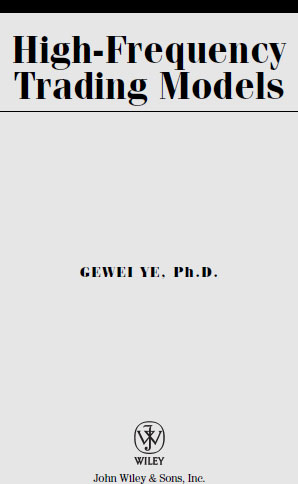
Copyright 2011 by Gewei Ye. All rights reserved.
Published by John Wiley & Sons, Inc., Hoboken, New Jersey.
Published simultaneously in Canada.
No part of this publication may be reproduced, stored in a retrieval system, or transmitted in any form or by any means, electronic, mechanical, photocopying, recording, scanning, or otherwise, except as permitted under Section 107 or 108 of the 1976 United States Copyright Act, without either the prior written permission of the Publisher, or authorization through payment of the appropriate per-copy fee to the Copyright Clearance Center, Inc., 222 Rosewood Drive, Danvers, MA 01923, (978) 750-8400, fax (978) 646-8600, or on the Web at www.copyright.com . Requests to the Publisher for permission should be addressed to the Permissions Department, John Wiley & Sons, Inc., 111 River Street, Hoboken, NJ 07030, (201) 748-6011, fax (201) 748-6008, or online at http://www.wiley.com/go/permissions .
Limit of Liability/Disclaimer of Warranty: While the publisher and author have used their best efforts in preparing this book, they make no representations or warranties with respect to the accuracy or completeness of the contents of this book and specifically disclaim any implied warranties of merchantability or fitness for a particular purpose. No warranty may be created or extended by sales representatives or written sales materials. The advice and strategies contained herein may not be suitable for your situation. You should consult with a professional where appropriate. Neither the publisher nor author shall be liable for any loss of profit or any other commercial damages, including but not limited to special, incidental, consequential, or other damages.
For general information on our other products and services or for technical support, please contact our Customer Care Department within the United States at (800) 762-2974, outside the United States at (317) 572-3993 or fax (317) 572-4002.
Wiley also publishes its books in a variety of electronic formats. Some content that appears in print may not be available in electronic books. For more information about Wiley products, visit our web site at www.wiley.com .
Library of Congress Cataloging-in-Publication Data:
Ye, Gewei, 1971
High-frequency trading models / Gewei Ye.
p. cm. (Wiley trading series)
Includes bibliographical references and index.
ISBN 978-0-470-63373-1 (cloth)
1. Investment analysis. 2. SpeculationMathematical models. 3. Portfolio managementMathematical models. 4. Financial engineering. I. Title.
HG4529.Y42 2011
332.64501dc22
2010024731
To my parents, Lei, Jessica, and friends
Preface
Lets start the book by explaining the title: High-Frequency Trading Models . First, there are three types of models of high-frequency trading: revenue models, theoretical (including behavioral, quantitative, and financial) models, and computer models. Revenue models are strategies, means, and ways to generate revenue and profit for a financial institution. Theoretical models are foundations for building computer models for high-frequency trading operations. Computer models refer to the computer algorithms (algos for short) that program the theoretical models and trading ideas. To summarize, the computer algos automate the trading ideas and the theoretical models with computer programming languages and technology infrastructure so that the revenue models of financial institutions may be materialized in a systematic way.
Thus, the high-frequency trading models may expand to the following: (1) existing revenue models; (2) new revenue modes, for example, high-frequency trading in derivatives markets; (3) theoretical (behavioral, financial, and quantitative) models for building unique investment strategies for high-frequency trading; and (4) computer algos for high-frequency trading and portfolio management. These four topics make up the central themes of the book.
Second, the high-frequency trading models belong to investment research and practice that are part of investment management. Investment management provides professional asset and portfolio management for financial institutions or private investors. As part of the functions of a financial institution, investment management provides the people, resources, and objectives to conduct high-frequency trading operations with the high-frequency trading models as the tools or goals. The advent of high-frequency trading may impact the investment management industry profoundly if not revolutionarily. As a result, investment management, including portfolio management, will benefit from computer algos e.g., Sentiment Asset Pricing Engine (SAPE) designed for high-frequency trading operations.
To elaborate, SAPE is a unique set of computer algos that are built on top of several Nobel models such as modern portfolio theory (MPT) and the capital asset pricing model (CAPM), the Black-Scholes option pricing model, and the autoregressive conditional heteroskedastic (ARCH) model, by engaging a human behavioral factor, namely, traders sentiment. Though the Nobel models have considered important elements such as risk and return, future-dated option pricing, and volatility clustering, traders sentiment can also affect stock prices. As the Nobel models did not consider behavioral factors in asset pricing, SAPE fills in the gaps by adding traders real-time sentiment to the equation. SAPE estimates future prices of individual assets by aggregating traders real-time sentiment. Compared to the Nobel models that provide theories and formulas, SAPE provides an end-to-end solution to portfolio management, including a new theory on behavioral investing, a new formula on estimating future prices of individual assets, and a new computer system for real-time future asset pricing, asset allocation, and market timing.
At a higher level of abstraction, SAPE for portfolio management, with a collection of computer algos for high-frequency trading, represents technology as the driver of financial innovation and risk management. SAPE algos reflect the principle that technology may have a profound impact on new financial instruments and applications. Similar to the probability theory driving inventions in portfolio management, insurance, and risk management, the advent of high-frequency trading, with an emphasis on information technology, may give rise to more liquidity in securities (especially derivatives) markets, and to inventions in investment management and risk management.
High-frequency trading has swept Wall Street with the stunning profit generated by top tier investment banks. In the meantime, high-frequency trading has been mentioned repeatedly in headline news such as congressional hearings on the practices of Goldman Sachs, and the record-high market volatility on May 6, 2010.
Many financial institutions, regulators, and financial professionals would like to know how high-frequency trading works, how it profits, and what is needed to build the algorithms with technologies available in the public domain. There is a lot of demand in the financial services and regulatory community for an in-depth book on this topic.
The audience for this book includes traders, regulators, portfolio managers, financial engineers, IT professionals, graduate or senior undergraduate students in finance, investment analysts, financial advisors, investment bankers, hedge fund managers, and financial institutions.
This book may be instrumental to the effort of reforming domestic or global financial systems and improving financial regulations. Imagine if financial regulators could develop a new high-frequency trading monitoring system based on the theoretical models and computer algos of this book. The monitoring system might automatically detect the preconditions of market anomalies and prevent the occurrence of undesirable anomalies. It would be especially useful for financial regulators to use computer algos to monitor and regulate trading. As a result, abnormal market behaviors like the one on May 6, 2010, could be anticipated.
Font size:
Interval:
Bookmark:
Similar books «High Frequency Trading Models»
Look at similar books to High Frequency Trading Models. We have selected literature similar in name and meaning in the hope of providing readers with more options to find new, interesting, not yet read works.
Discussion, reviews of the book High Frequency Trading Models and just readers' own opinions. Leave your comments, write what you think about the work, its meaning or the main characters. Specify what exactly you liked and what you didn't like, and why you think so.

